Wine Enthusiast |
| The Italian Winemakers Reviving an Ancient Region Posted: 03 Aug 2021 05:00 AM PDT  In the northernmost province of Basilicata, which stretches up from the arch of Italy's boot, lies a mountainous, wild area. It recalls the brisk Alps of the north more than warm, southern climes. There, anchored around the extinct Monte Vulture volcano is a patchwork of ancient towns scattered among the undulating foothills that harbor some of the country's most exciting, site expressive wines. The region is home to two denominations: Aglianico del Vulture Denominazione di Origine Controllata (DOC), established in 1971, and the Superiore Denominazione di Origine Controllata e Garantita (DOCG), which was established in 2010 and is the only DOCG in Basilicata. Grown here at elevations up to 2,000 feet, Aglianico is a late-ripening variety that benefits from the area's cool, dry yet sunny, mountainous terrain and yields energetic, structured reds that can deliver power and finesse in equal measure. Commercial winemaking in the area dates back nearly a century, but a new generation of winemakers has brought this historic area to the forefront. Get to know these wineries to best explore Italy's most dynamic wine region. 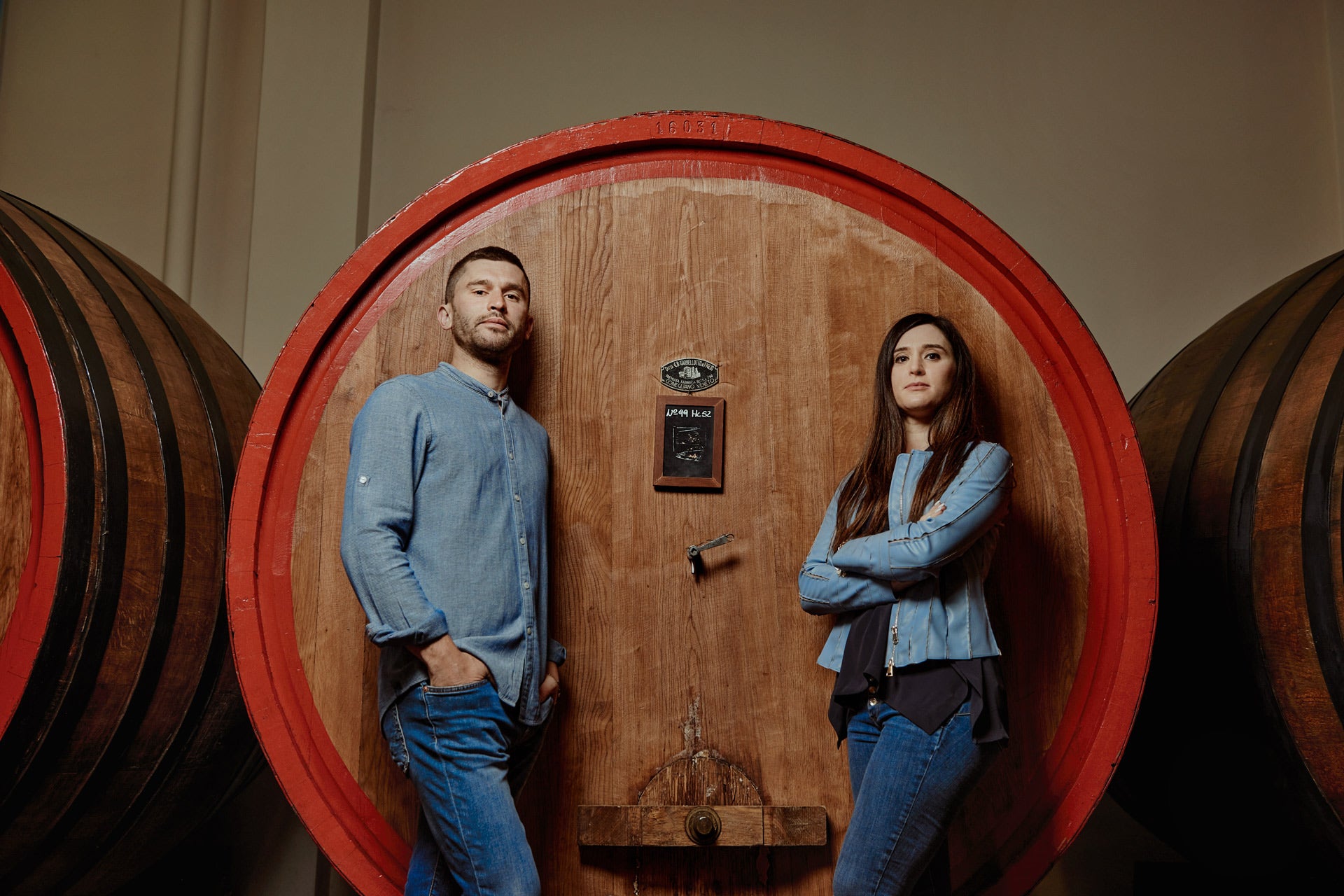 D'AngeloRocco D'Angelo, WinemakerErminia D'Angelo, Export ManagerOne of the oldest, most established wineries in Vulture, D'Angelo walks a fine line between tradition and innovation. The family-run winery's beginnings span back a century, and for the first few decades, it was predominately in the bulk wine business—an origin story echoed across southern Italy. It wasn't until the 1950s that the winery shifted its focus and began to bottle just its own wine under the Casa Vinicola D'Angelo label. It was one of the first wineries to produce bottles labeled as Aglianico del Vulture DOC. Currently helmed by the family's fourth generation, the winery is managed by a sister-brother duo: Erminia, who runs the commercial side of the business, and Rocco, the winemaker and vineyard manager. After their father, Lucio, passed away in 2007, Erminia and Rocco followed in his footsteps. "My brother and I started to manage the winery so very young," says Erminia. "But we grew up in the winery playing between barrels and barrique because our childhood home is on the top floor of the winery."  Vinification of their red wines follows traditional methods in the winery's large concrete tanks that were constructed in the early 1960s. The tanks are used for maceration, fermentation and aging. Erminia notes that "with the concrete tanks you have slow and natural maturation with good micro-oxygenation of the wine," which is key for the proper evolution of Aglianico. While the winery's production areas are in the town of Rionero in Vulture, its nearly 62 acres of vineyards are in the nearby town of Barile and the more distant town of Maschito. The Barile vineyards sit at the foot of Monte Vulture, around 1,300 feet in elevation, with volcanic tuff dominating the soils. The Maschito vineyards are down the slope, in a warmer area that shows more clay-driven soils. This diversity of site contributes a range of Aglianico expressions to the winery's portfolio. The Aglianico del Vulture, Caselle and Canneto labels are sourced from Barile, yielding zesty, mineral-driven wines that express the volcanic soils. The Tecum label is sourced from 80-year-old vineyards in Maschito, resulting in a rich, concentrated and earthy expression. Azienda Agricola Elena FucciElena Fucci, Owner/WinemakerA native of Barile, Fucci grew up wanting more than what was offered by a sleepy town in the shadow of Monte Vulture. Her parents, both teachers, encouraged her to follow her passions. By the time she went to university, Fucci was hard set on leaving Barile behind. But that all changed in 2000, when her grandfather, Generoso, was looking to sell the land that she and her family grew up on, which included nearly 15 acres of Aglianico planted on the highest part of the contrada Solagna del Titolo. Faced with the prospect of losing the land her grandfather had tended since the 1960s, Fucci had a change of heart. That year, she started studying viticulture and oenology at university in Pisa and began her eponymous winery. "I started to make one wine because I have a single vineyard," says Fucci of her iconic Titolo bottling, which was named after the contrada in which the vineyard resides. "Maybe I produce only one label, but better." 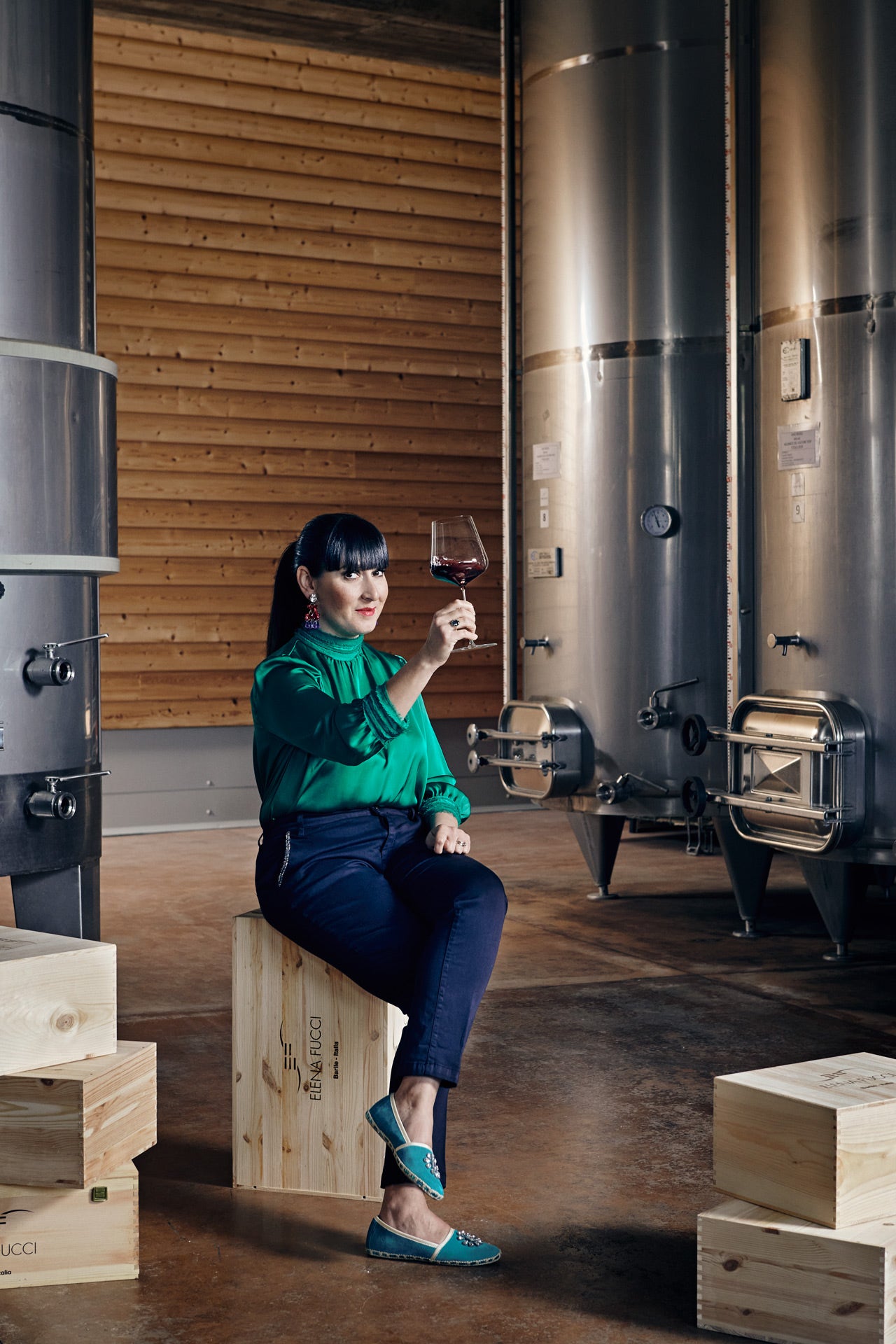 She started out making a minuscule 1,200 bottles of Titolo in 2000. Production has since reached 25,000–30,000 bottles. It still only represents roughly half the yield allowed by the Aglianico del Vulture DOC for a plot of her size. Fucci has also expanded her portfolio, albeit only slightly. The 2017 vintage was the first release of Titolo by Amphora, which spends 10 months in untreated Italian terra cotta. She more recently released Titolo Pink, an Aglianico rosato made from her vineyard's youngest vines, between six and 10 years old. Perhaps her most endearing addition is the Sceg bottling. It comes from four plots of neighboring vineyards owned by friends of her grandfather. The sites were at risk of going untended or being sold. But wanting to continue the legacy of these 70-plus-year-old Aglianico vines, Elena agreed in 2016 to maintain their vineyards and create a wine in their honor. Sceg means pomegranate in Arbëreshë, the local dialect spoken by the inhabitants of the area, including Elena and her family, who are descendants of Albanian refugees. The fruit signifies good luck and prosperity, and Sceg sheds light on a culture that is slowly fading and gives new life to nearly forgotten vines. 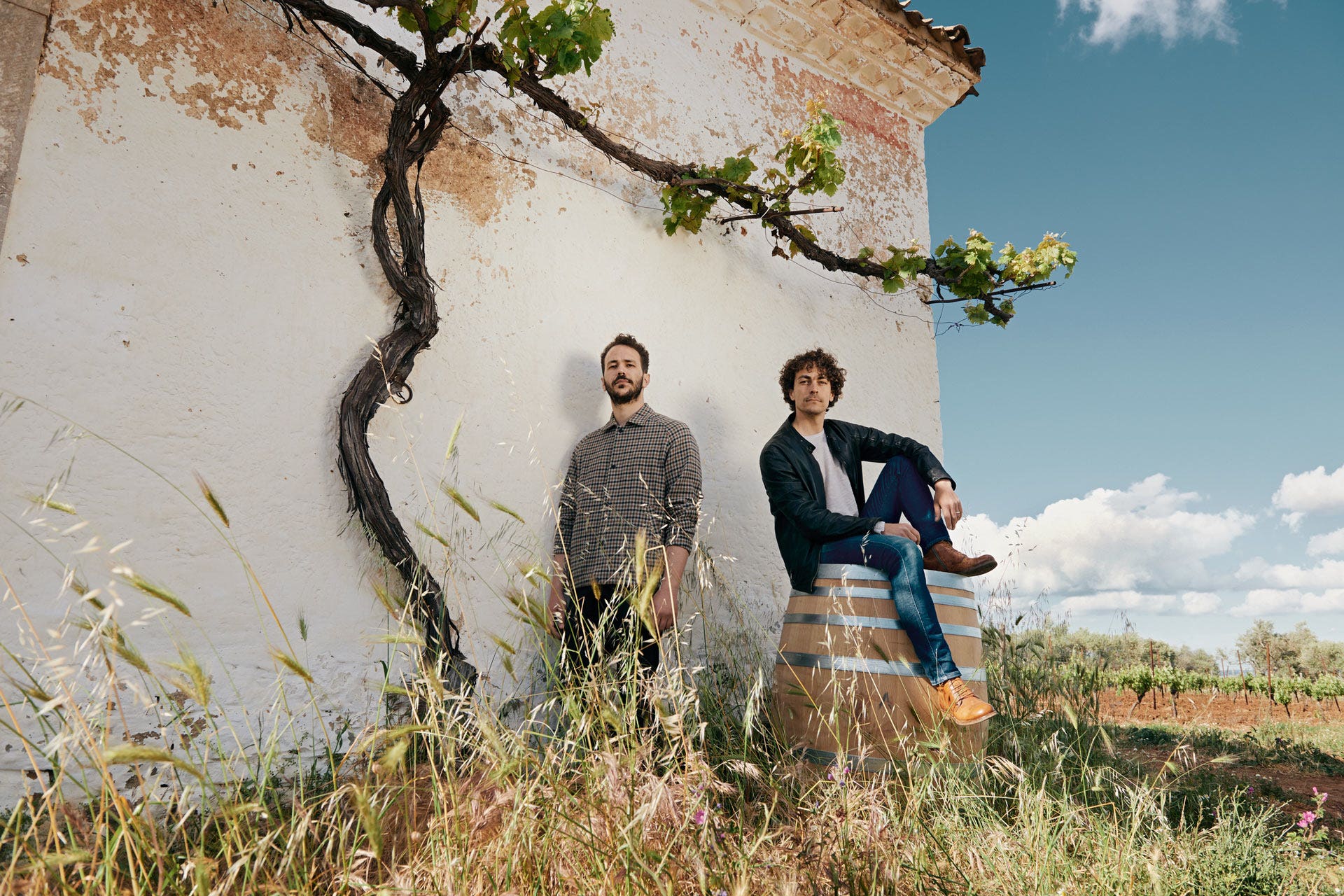 GrifalcoAndrea Piccin, Co-owner, Sales ManagerLorenzo Piccin, Co-owner, WinemakerBoundary-pushing wineries are often led by those who think beyond their regions. They draw inspiration from winemaking and viticultural practices of other areas. The best do this with a sense of reverence for their land and terroir. This is Grifalco. Fabrizio and Cecilia Piccin founded the business in 2004. The couple came to Basilicata with knowledge and experience from over a decade in Tuscany, where they owned and managed the Salcheto estate in Montepulciano. In the 1990s, Tuscany was going through a boom, with investors snatching up properties. The Piccins took the opportunity to sell their winery and look to other areas in Italy to start a new business. "Aglianico and the Vulture area back then were completely unknown," says Andrea, son of Fabrizio and Cecilia. "So, if you wanted to make something moneywise, as an investment, Vulture was the perfect place to do it." The winery is now led by Andrea, who runs the commercial side of the business, and his brother Lorenzo, the winemaker. They bring new focus and drive, but they're still appreciative of their parents' experience and foresight.  "One of the best things my father did when he came here is he didn't buy one piece of big land around the cellar," says Lorenzo. "Instead, he bought many parcels in different villages. He had in mind that this place is great because each village can have its own microclimate, different terroir, different soil composition." The family owns nearly 40 acres of organically farmed vineyards spread across the four villages of Venosa, Ginestra, Maschito and Forenza. Vine age ranges from 10 to 80 years, and each parcel is fermented separately. Lorenzo draws inspiration from Piedmont, where he studied viticulture and oenology. The superficial ties between Nebbiolo and Aglianico are nothing new—both yield tannic, ageworthy wines that express terroir. For the two cru wines, Daginestra and Damaschito, he decided to apply the technique of extended maceration in 5,500-liter oak vats, which was historically used in Barolo. With minimal pumpovers during the 50–60 day period, the wines slowly extract. After two more years refining in large oak and one in bottle, the resulting wines are elegant yet ageworthy.  PaternosterFabio Mecca, WinemakerFounded by Anselmo Paternoster in 1925, this historic winery is one of the defining pillars of Vulture. It has evolved with the times and has been a leader in bringing a more modern winemaking style to the area. As one of the first formally trained winemakers in the area, Anselmo's son, Pino, was very much the main driver behind this call to modernity. In the 1970s, he led the charge along with other historic wineries, like D'Angelo, to bottle Aglianico with the newly approved DOC. Additionally, in the mid-'80s and early '90s, formal training led him to eschew the more commonly used local chestnut barrels and employ Slavonian and French oak, yielding a more refined expression. Today, the winery is led by Fabio Mecca, winemaker and fourth generation of the Paternoster family. He continues the legacy, producing a range of Aglianico and Falanghina bottlings from 50 acres of organic vineyards throughout Barile. "It's easy for us [to be organic] up to a certain point," says Mecca. "We are [2,132 feet] in elevation, and therefore, we are very well-ventilated in this zone." Yet, he is quick to note that the area is not without its difficulties. Aglianico is a late-ripening variety that is often harvested at the end of October to early November. Weather conditions that late in the season can be unpredictable, so attention to detail in the vineyard is key to ensure proper ripeness. With six wines in the current portfolio, total annual production at Paternoster is around 100,000 bottles, making it a relatively small operation. Most of the volume is accounted for by the entry-level Synthesi bottling, an Aglianico from a blend of vineyards in Barile. The top Aglianicos of the estate come from two single vineyards, Rotondo and Don Anselmo. The former is the site of the current modern wine cellar and an area purchased by Pino in the mid '70s, while the latter is a low-yielding site named after the winery's founder. In 2016, Paternoster became a part of Tommasi Family Estates and is now managed by the Veneto-based wine firm. The winemaking is still directed by Mecca, and the wines now benefit from a distribution network that spans approximately 30 markets.  BasiliscoViviana Malafarina, General Manager/WinemakerIt takes a special person to steward some of the most historic vineyards in Italy while also maintaining a winery building constructed in the 16th century that sits above caves dug a century earlier. Malafarina is exactly the right person for this job. Her path was circuitous. After earning a degree in Slavic languages and teaching for a stint in Kiev, Ukraine, she worked as a chef and sailor on a superyacht and then as a tour leader on the Orient Express, catering to guests from across the world. It was there she met Antonio Capaldo, chairman of the Campanian firm Feudi di San Gregorio, who offered her the opportunity to manage his newly acquired Vulture endeavor, Basilisco. Malafarina moved to Barile in 2011 to take on her new post. She quickly fell in love with the surrounding vineyards, where she worked alongside Pierpaolo Sirch, who was the agronomist for Feudi di San Gregorio. Over the years, she started to help more in the cellar under the direction of a few consultant winemakers, including Lorenzo Landi and Denis Dubourdieu. Since 2013, winemaking has been under her charge. With an annual production as small as 65,000 bottles, she often works alone in the cellar. The roughly 60 acres of organically farmed vineyards also fall under her purview. As a self-described "soil freak," she vinifies each vineyard separately to best express the unique soil, aspect and elevation of each. 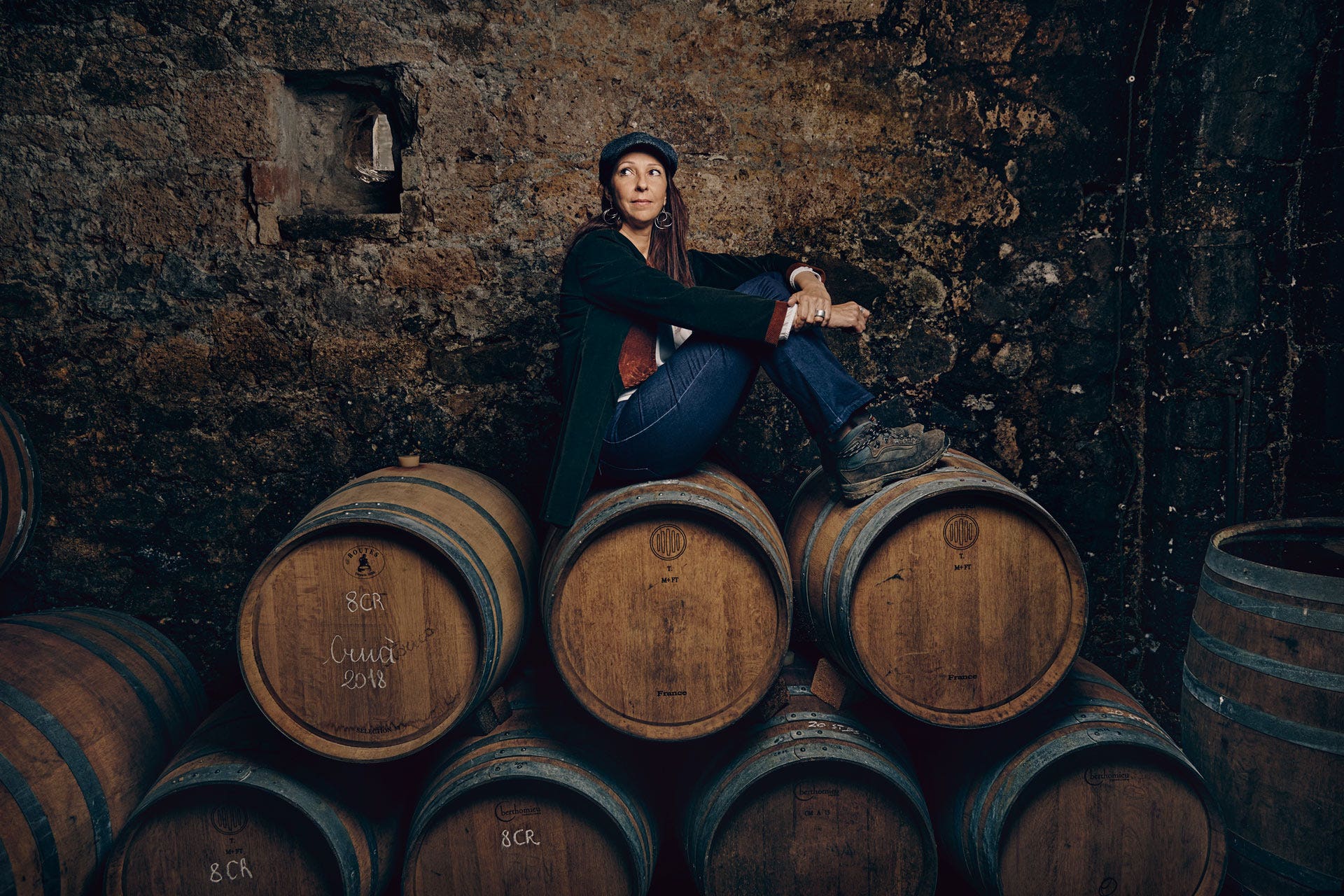 She later decides to either blend the wines, as in her Teodosio and Basilisco labels, or bottle them separately, like in her three Aglianico crus: Cruà, Fontanelle and Storico. These are microexpressions of time and place. They're labors of love for Malafarina, but one in particular might be nearest to her heart. The Storico vineyard is a nearly five-acre plot of 80-plus-year-old ungrafted Aglianico planted using the capanno training method, a historical trellising system. It's a living museum of vines with yields that are a tenth of what is allowed by the Aglianico del Vulture DOC regulations. In the wine world, "everybody's trying to go back the past. To go back to the authenticity, to the old days," says Malafarina. "We are still there in Basilicata."  Musto CarmelitanoElisabetta Musto Carmelitano and Luigi CarmelitanoA small, family-run operation, Musto Carmelitano is an excellent example of what a hands-off approach to winemaking can do with old-vine fruit. Located in the town of Maschito, the winery was built in 2006 and is managed by sister and brother, Elisabetta and Luigi. While the history of the winery itself is rather short, the family's time in the area and investment in the land stretches back generations. When Elisabetta and Luigi started the winery in the mid-2000s, they were fortunate to inherit nearly 7.5 acres of vineyards spread across three sites planted to Aglianico vines that ranged from 30–80 years old. The two oldest vineyards, Pian del Moro and Serra del Prete, were planted by their grandfather and uncle. While these sites are located within the Maschito township, the soil composition varies between the vineyards and results in different outcomes. Pian del Moro, the older of the two vineyards, has a black, sandy soil with some calcareous elements. This highly volcanic soil has made it resistant to phylloxera, and many of the vines are used for prorogating the estate's other vineyards through grafting. Serra del Prete has various types of soil, ranging from clay-driven veins to well-draining, rocky terra rossa and also some white calcareous soil. "Obviously the whole area is made up of these differences in the colors of the soil," says Elisabetta. "[Yet] the thing that unites them is the clay-driven part which nourishes the roots and also helps in periods of drought." The winery's Pian del Moro and Serra del Prete bottlings are the top Aglianico expressions of the estate. Following a more traditional path, the former spends a year in used tonneaux and results in a polished, ageworthy Aglianico that shows a deft use of oak. The latter takes a more wild path, using a pied de cuve sourced from the vineyard to start the fermentation. It then spends six months in stainless steel and six months in concrete, which yields a crunchy, juicy red wine with soft tannins—a style of Aglianico not typically seen in an area known for burly reds. |
| Why Aren’t Bar Pros Returning to Work? A Lack of Empathy. Posted: 03 Aug 2021 04:30 AM PDT  As bars and restaurants start to reopen, business owners face staffing difficulties. "I couldn't find people to hire," Camila Ramos, an owner of Miami's All Day restaurant, told The New York Times in April. Last month, a Bloomberg article reported that more than 50% of U.S. hospitality professionals don't plan to return to their old jobs. Why is it so hard to entice workers to come back? In addition to pressing issues like health risks, low pay and lack of benefits, some hospitality professionals hesitate to return to their old jobs due to a dearth of empathy in the field. "As [front-of-house] employees, we're asked to be empathetic towards our guests," says Ben Wald, head of bar programming at Yuco. "So, to turn around and not have that same level of empathy from ownership or management is just unacceptable, especially now." Wald left a corporate bartending job because he developed an unhealthy relationship with alcohol to cope with his toxic work environment. He says he was once berated for requesting time off too far in advance, had to wait until the week before his requested dates to find out if he could take off and was blamed for bar issues beyond his role while away. This experience shaped how he approaches job prospects. "When I did look for a new job, I asked [prospective employers] about the importance of work-life balance, how far out schedules would be released, the timeline for time-off approval and goals for professional development," says Wald. 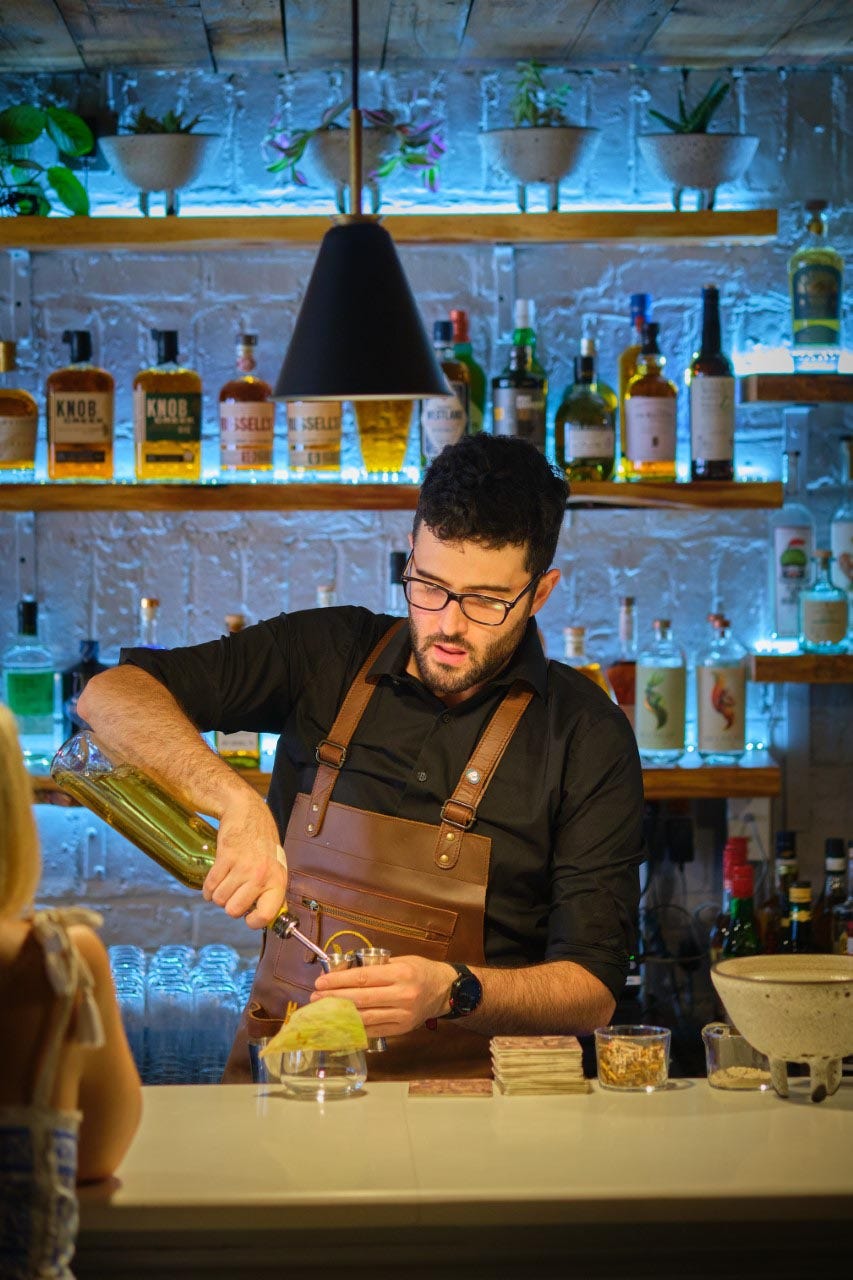 Alex Jump currently works in hospitality, and has endured similar situations. "I was a bar manager in my early 20s, and there was a sudden death in my family that required me going out of town for a week," says Jump, now the head bartender of Death & Co Denver and host of the podcast Focus on Health. "When I returned from the trip, the owner of the restaurant sat me down and told me that my actions were not representative of a person in mourning, and that my trip with my family had burdened everyone else at the restaurant. "Had this owner empathized with what my family was experiencing and how we chose to mourn this loss, I doubt that this conversation would have occurred at all," says Jump. Would changing workplace dynamics mitigate hospitality staffing shortages? While better salaries and benefits are absolutely vital, some researchers, mental health professionals and hospitality workers believe empathy could create a more sustainable industry. Understanding EmpathyCarl Rogers, psychologist and author of Client-Centered Therapy (1951) and On Becoming a Person (1961), described empathy as viewing the world through other people's eyes, not viewing your world reflected in their eyes. To be empathic, Rogers wrote, you have to be sincerely curious about those around you. The term is often confused with sympathy, which involves being moved by or in tune with another person's experiences. Empathy, on the other hand, requires deep, genuine emotional connections.
It has become a corporate buzzword, too. "Businesses have latched to the word because they are aware that it is a human need and capacity that is necessary for a functioning business and society," says Dr. Helen Riess, founder and CEO of Empathetics Inc. She's also an associate professor of psychiatry at Harvard Medical School and author of The Empathy Effect. "The biggest misinterpretation of empathy is that people often think it means giving in to everything people say they want, rather than understanding what they really want and need," she says. Businessolver, an SaaS-based benefits technology provider, surveys CEOs, human resource professionals and other employees across six industries and four generations for its annual State of Workplace Empathy Study. The 2021 results show that, in the nearly 2,000 survey participants, only one in four employees believes their organization is sufficiently empathetic. Hierarchical distinctions in perceptions abound in the study as well. Only 58% of employees believe their employer openly discusses mental health issues, while 86% of CEOs believe they do. Empathy at the BarBars can have complicated group dynamics. To provide a positive experience while serving food and drinks, the staff interacts with each other and their guests. Meanwhile, guests interact with the staff and, sometimes, other guests. In a healthy environment, empathy will be at the core of all this communication, whether you're a food runner, general manager, first-time guest or bar regular. The tone is typically set from the top down. "Being empathetic as a leader, in my opinion, creates a culture of understanding and 'safe spaces' for staff," says Taylor Duggan, beverage director for New Jersey-based Skopos Hospitality Group. "To me, it helps us really get to the root cause of why a team member may or may not be performing up to expectations and allows us to tackle that cause in a way that is effective and re-creatable." She uses the example of a manager who sees a messy bar during service, and speaks to the bartender constructively after closing. "Fixing something during service is reactionary, and you could unintentionally approach the situation negatively," says Duggan. She suggests posing compassionate questions, such as what can we do to make you a cleaner worker? Are you feeling overwhelmed during service? If so, why? Could we offer you additional or different training to help you feel less overwhelmed? With guests, Duggan believes empathy means engaging everyone with an open mind. "It's about having a conversation to make a guest feel safe and welcome and finding a way to enhance their experience for that moment," says Duggan. "You can't do that without listening to their needs which are expressed both in their words and actions." Scenarios that require empathy in bars abound. A guest might worry about another group's lack of respect for mask mandates, or a bartender might struggle to keep up while their teammates work quickly. Each situation can escalate into arguments, or they can be resolved amicably if all practice empathy. A manager could reassign one bartender to a slower shift, or offer them additional training. They might also step in to request politely that a guest wear a mask on behalf of the establishment. Empathy and SuccessThere are certain roadblocks for even the most well-intentioned bargoers or hospitality professionals to successfully practice empathy. "Research shows that empathy is highest for people who are most like ourselves… for people who have suffered in similar ways, and for people who share a common goal," says Riess. However, empathy and compassion can be learned. They're acquired skills, not inherited traits, writes Claire Cain Miller in The New York Times. "There are steps people can take to acknowledge their biases and to move beyond their own worldviews to try to understand those held by other people." 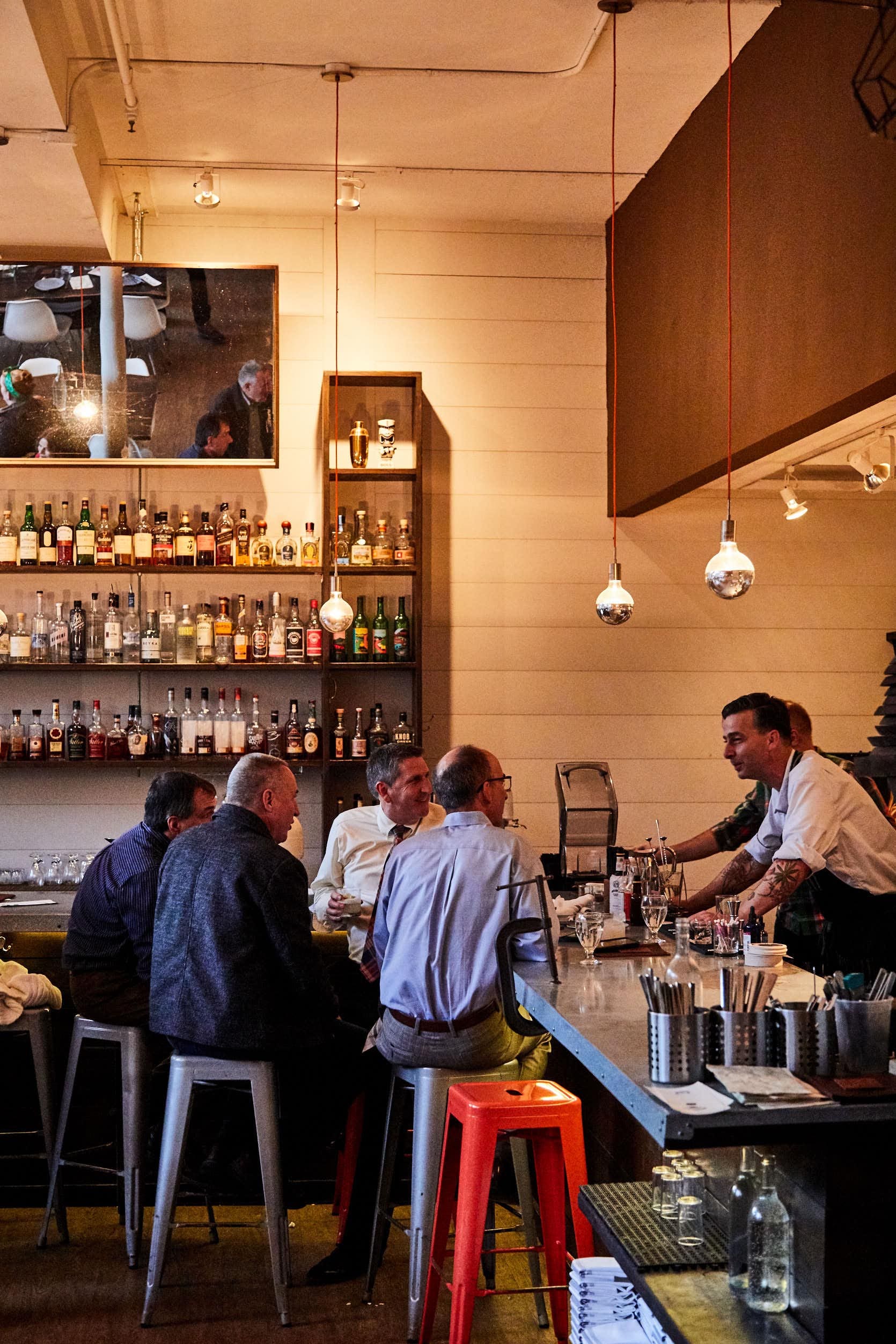 At the bar, when guests and staff feel seen and actively listened to, they almost immediately share a deeper, more valuable set of information with everyone around them. Bar managers and other leaders must champion this practice to ensure it's implemented daily, and to hire and train staff accordingly. "Empathic leaders will know what affects the heartbeat of their organizations," says Riess. "It is one of the most important traits of great leaders, and also one of the hardest to find." She believes bar owners and operators must ask the right questions during the interview process to determine whether potential managers will create compassionate workplaces. "Asking the person how they would respond to some typical conflict that arises in the bar industry with coworkers, patrons and outside authorities will provide some insight into whether they are able to take the perspective of others, or whether they are quick to form judgments, become defensive, or have a lack of curiosity about what may be going on for the other person," says Riess. She says that good leaders will inspire their staff by addressing what matters to them and creating workplaces that make people feel like they matter and belong to something important. "Listen to your staff, and most importantly, actively listen, rather than listening while also thinking of responses to their comments," says Jump. "Creating this safe place for workers to feel value not only increases team morale, but also productivity." With empathic leaders at the helm, bars and restaurants can become safer, more sustainable workplaces. Many workers say that bars like Death & Co, Portland Hunt + Alpine Club, Smuggler's Cove, and those within Skopos Hospitality Group have created positive environments for them to prosper and succeed. It's a sign of growth in an industry struggling to re-emerge and evolve. |
| You are subscribed to email updates from Wine Enthusiast. To stop receiving these emails, you may unsubscribe now. | Email delivery powered by Google |
| Google, 1600 Amphitheatre Parkway, Mountain View, CA 94043, United States | |















0 comments:
Post a Comment